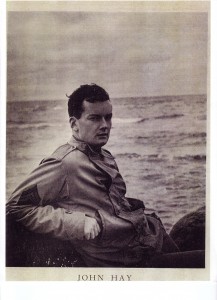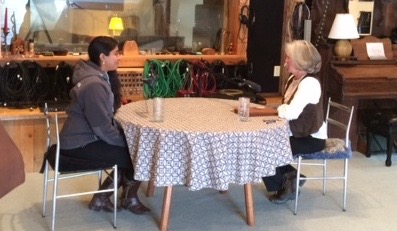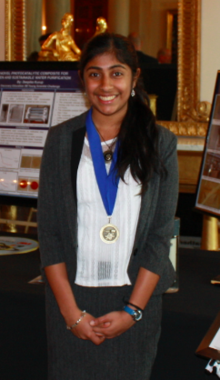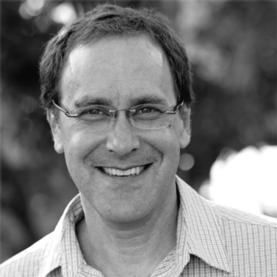
A rare interview made available to us through a Friend of Story.
Kearsarge Valley Magazine’s Library of videotaped interviews, stretching back some 25 years, has been made available to Story Preservation thanks to the generosity of Friend and Supporter, Gail Matthews.
Gail is the former producer and host of the Yankee Cable Network program, Kearsarge Valley Magazine. Segments were filmed by Will James, the founder of YCN. In ways similar to Story Preservation, Kearsarge Valley Magazine featured interviews of people from all walks of life with interesting stories to tell. Many of Gail’s stories complement those in our collection. We’re in the process of transferring the videos from VHS format to DVD.
.
First up, American author, naturalist, and conservation activist, John Hay.
.
Here’s some background, taken from the Brown University Special Collections Library where his papers are archived, as is the photo of one of his journals, below. The journal is, what one would call, the real deal!
 John Hay was born in 1915, ten years after the death of his famous grandfather and namesake, John Milton Hay (1838-1905), a Brown alumnus (Class of 1858), poet and diplomat. Clarence L. Hay, father of the younger John Hay, was an archaeologist who, after doing some exploration in Mexico, served as curator of Aztec and Mayan civilizations at The American Museum of Natural History in New York. He was also an amateur botanist.
John Hay was born in 1915, ten years after the death of his famous grandfather and namesake, John Milton Hay (1838-1905), a Brown alumnus (Class of 1858), poet and diplomat. Clarence L. Hay, father of the younger John Hay, was an archaeologist who, after doing some exploration in Mexico, served as curator of Aztec and Mayan civilizations at The American Museum of Natural History in New York. He was also an amateur botanist.
Clarence L. Hay married Alice Appleton, and the younger John Hay was born at the Appleton family estate in Ipswich, Massachusetts. The younger Hay was raised in New York City , attended St. Paul’s School in Concord, New Hampshire and had the privilege of spending his summers at The Fells, his late grandfather’s estate on Lake Sunapee.
Hay attended Harvard, and on graduation worked as Washington correspondent for The Charleston News and Courier. Just before going into the army, Hay apprenticed himself to Conrad Aiken, the poet, who was then living in Brewster, Massachusetts, on Cape Cod. Hay divided his time in Brewster between clearing land and writing poetry. Before leaving for the service, Hay bought what he thought was 10 acres of land on the top of a nearly treeless hill, close to Aiken’s home called “41 Doors.” He spent some of his tour of duty in the Army as an associate editor of Yank, the army newspaper.
After his discharge, he and his new wife, Kristi Aresvik Putnam, settled on what turned out to be Hay’s 18 acre lot to raise their family, which eventually numbered four, on Cape Cod. Hay worked as a freelance writer and reviewer, and privately published a book of his poetry. His love of the Cape and of his grandfather’s land in New Hampshire led him to combine observation of nature with his writing skills. This resulted in a 1959 publication entitled The Run, almost immediately recognized as a classic in the field of nature writing. John Hay continued to observe and to write, but he was also an activist and an educator. He taught at Dartmouth from the early 1970’s into the 1980’s. He had previously co-founded the Cape Cod Museum of Natural History with other local educators in 1954 and helped to establish its many outreach programs. He served as the Museum’s second president and held that post for 25 years. He joined the Brewster Conservation Committee, persuading the town to take over 200 acres of salt marsh by eminent domain, to ensure that some land on the rapidly developing Cape remained in public hands. His many honors include selection as Phi Beta Kappa poet at Harvard in 1963, and the John Burroughs Medal in 1964, garnered for his book The Great Beach. He was named conservationist of the year by the Massachusetts Wildlife Federation in 1970. In 1991, the Orion Society established the John Hay Award, given annually to an author who excels in addressing the relationship between man and nature, environmental education and conservation, in his honor. The Society for the Protection of New Hampshire Forests named him Conservationist of the Year for the second time in 1993.

John Hay’s Grandfather’s Home / The Fells, Sunapee, NH
Through his books, his poetry, his college lectures, the museum and his life, John Hay has spread the message that man is only part of nature, not in control of nature. He died in Bremen, Maine on February 26, 2011.
Other upcoming videos made available to Story Preservation by Gail Matthews / Yankee Cable Network: Naturalist / Writer, David Carroll; Poet, Maxine Kumin; and New Hampshire’s forever favorite, Babe Sargent. And that’s just the beginning!
.
.
Tech transfer underway. Check back soon for video upload!
.
Support of our work comes in many forms and …










 Sy’s 20 books for both adults and children have garnered many honors. The Soul of an Octopus was a 2015 Finalist for the National Book Awards. The Good Good Pig, her memoir of life with her pig, Christopher Hogwood, is an international bestseller. She is the winner of the 2009 New England Independent Booksellers Association Nonfiction Award, the 2010 Children’s Book Guild Nonfiction Award, the Henry Bergh Award for Nonfiction (given by the ASPCA for Humane Education) and dozens of other honors. Her work with the man-eating tigers, the subject of her book Spell Of The Tiger, was made into in a National Geographic television documentary she scripted and narrated. Also for National Geographic TV she developed and scripted Mother Bear Man, about her friend, Ben Kilham, who raises and releases orphaned bear cubs, which won a Chris award.
Sy’s 20 books for both adults and children have garnered many honors. The Soul of an Octopus was a 2015 Finalist for the National Book Awards. The Good Good Pig, her memoir of life with her pig, Christopher Hogwood, is an international bestseller. She is the winner of the 2009 New England Independent Booksellers Association Nonfiction Award, the 2010 Children’s Book Guild Nonfiction Award, the Henry Bergh Award for Nonfiction (given by the ASPCA for Humane Education) and dozens of other honors. Her work with the man-eating tigers, the subject of her book Spell Of The Tiger, was made into in a National Geographic television documentary she scripted and narrated. Also for National Geographic TV she developed and scripted Mother Bear Man, about her friend, Ben Kilham, who raises and releases orphaned bear cubs, which won a Chris award.








